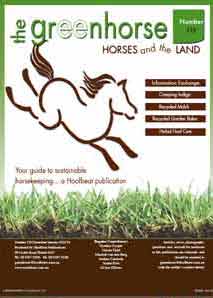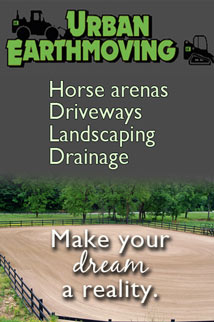The Green Horse section provides practical information on managing environmentally sustainable horse properties, readers stories and tips, as well as advice and articles from equestrian experts in their fields.
February March 21
Vol 42 No 5
In this issue of The Green Horse you will find the following articles
QUAD BIKE REGULATION
The Federal Government is making moves to increase the safety of the use of Quad bikes on farms and equestrian properties.
KNOW YOUR PESTS- TERMITES.
Last issue we discussed some of the signs indicating you might have termites, as well as some of the areas on your property where you
might find them. Finding you have termites is one thing, but what do you do once you find them?
by Rhiannon Brown - Envirapest
STABLE DANGERS by Liz Tollarzo
Being aware of potential dangers in the stable - and addressing these - may help aleiviate injury.
ARENA MAINTENANCE -FOR ALL SEASON USE
by Wendy Elks
When the dream of having your own arena is realised, it doesn't mean that the work is over.
TREES ON THE PROPERTY
Shade, shelter, wind and soil erosion.
For those with horses, trees offer shelter, shade and increase the aesthetics of your property.
by Celine Boennelykke
HERBS TO MOTIVATE YOUR HORSE
When we are frustrated with trainng and riding, there may be a reason the horse is unwilling to co-operate or to share the same ambition for a transition you desire.
by Catherine Bird for Country Park Herbs
WIN A YEAR'S SUBSCRIPTION...
share your equine property management tips and each issue one reader will win.
Send ideas to -
The Green Horse Support <greenhorse@hoofbeats.com.au>


PREVIOUS ARTICLES
Available on line
Dec/Jan 20/21
HORSES AND HONEY BEES-
Can they share space on the property?
by Wendy Elks
Oct/Nov 20
SOLAR-POWERED PRODUCTS
by Celine Bønnelykke
In previous issues we have discussed the economics of setting up a solar-driven property, but if finances don’t stretch to installation of the whole package, there are ways to ease into the solar-world.
Aug/Sept 20 THE HIDDEN DANGERS IN OUR PADDOCK.
by Elizabeth Tollarzo
Horses love to run, play, buck and then run again and we often, through lack of risk assessment or management practices, place them in areas that are fraught with dangers.
JUNE JULY 20 GOING SOLAR ON THE HORSE PROPERTY Where to put your panels Part 2
Once you have selected what solar system best suits your needs, then you need to look at how you can maximise the advantages.
APRIL MAY 20 GOING SOLAR ON THE HORSE PROPERTY Part 2
Once you have selected what solar system best suits your needs, then you need to look at how you can maximise the advantages.
FEB/MARCH 20 ANTS AWAY
by Mark Brown Envirapest
So, what can you do to deter ants from your house and your stables??
DJ19/20 KEEPING SNAKES OUT OF THE STABLE by Wendy Elks
Snakes may be protected under Wildlife regulations in Australia, and they may be great for keeping the mice and rats down, but do we want to find them in our stables near our horses and pets?
ON19 - TERMITES- common myths
by Rhiannon Brown, Envirapest
Your house and stables are looking wonderful this spring, but do you know what is happening inside the walls of your brick or timber building?
AS19 - OUCH THAT HURTS
by Catherine Bird for Country Park Saddlery
The extent of the swelling is usually an indication of the severity of the infection or injury and the cause needs to be established before giving herbs.
JJ19 - MANAGING PASTURE
by Rhiannon Brown, Envirapest Healthy pasture means healthy horses.
A/M19 - STOP THOSE WEEDS
Property biosecurity
by Rhiannon Brown, Envirapest
Putting simple precautionary steps into place can make it tough for weeds to get a hold on your equine paradise.
|
  
  


by Liz Tollarzo
They say that horses are accidents-waiting-to-happen as they are inclined to find every conceivable way to injur themselves, usually just before a competition. Being aware of potential dangers in the stable - and addressing these - may help aleiviate injury.
STABLE DANGERS
 Stable walls and partitions need to be solid to be able to withstand kicks or the weight of the horse should it get excited. If the walls are made from brick, this should be done with double brick on the inside walls at least halfway up to the roof in case the horse kicks out or becomes cast. Stable walls and partitions need to be solid to be able to withstand kicks or the weight of the horse should it get excited. If the walls are made from brick, this should be done with double brick on the inside walls at least halfway up to the roof in case the horse kicks out or becomes cast.
A horse can become cast when it lies down or rolls over next to the wall and is unable to rise. It is a dangerous situation for the horse (if stuck for a long period of time it can develop fatal colic or be injured in its attempts to rise) and for people. The horse must be rolled over so it is not facing the wall - requiring ropes to be fastened to its legs and ideally two or more helpers to assist.
To prevent this from happening, a stable should preferably have a casting groove or strip on the inside of the walls, so a horse can get purchase on the wall should it become cast, enabling it to push itself away enough to rise.
If using lots of bedding, it may also help to bank your bedding higher against the wall; or in the case of rubber matting, or similar, using less bedding and placing it in the middle of the stable which encourages the horse to lay in the deepest part. Depending on the individual horse’s habits, the best prevention will need to be decided on as a cast horse can be a very dangerous situation.
STABLE LINING
When your stable or outdoor shelter is constructed of tin, it is very important to have a ‘kickboard’ lining on the inside to protect your horse’s legs. A horse can kick through tin very easily, especially if it’s rusty. This lining can be plywood panels, timber or rubber and preferably should extend half way up the walls. Even an outside shelter in a paddock must have kickboards to prevent accidents since a horse may enter the shelter and decide to roll, become cast and either kick through the tin or even get its legs stuck under the tin walls! Prevention is certainly better, and less expensive than a cure.
STABLE BEDDING
Various councils have different requirements for stables, which is important to know to ensure your horse facilities are approved.
Dirt floors can be left, depending on if the ground is soft enough to lie on, but it won’t take long for ammonia to build up if the soil or dirt is not dug up and replaced often.
Limestone or cracker dust can provide a safer base for a stable - being less slippery than cement - but will still require bedding.
Cement floors will always require shavings, sawdust, straw, sand or other stable bedding to encourage a horse to urinate and lie down comfortably without injuring itself. Each bedding has advantages and disadvantages, i.e. if using straw be aware that greedy horses like to eat their bedding, and if using sand know that it can cause colic issues with horses ferreting in the sand dropped food.
 MESH DIVIDERS MESH DIVIDERS
Any mesh or bar partitions within the stable need to be small or close enough together that a horse cannot get a hoof through it. You may think bars are close, but if they are over a long distance then a good kick can drive the horse’s hoof between them. The bars then close back and trap the leg.
Steel mesh needs to be very small squares and thick in diameter, the smaller the square the better as there is less chance of a hoof being trapped in it.
Horse shoes can become stuck on medium sized mesh - the main rule here is the smaller the safer! Generally, the kick boards will be halfway up the sides of the stable and then the mesh will continue to the roof. If the mesh starts from the ground level then it will have to be small, strong and reinforced.
Entrapment in mesh or bars is a very common accident so it’s better to safeguard your horse’s future - as the outcome of a leg being trapped is not a good one. Regularly inspect mesh between horses for damage and any sharp points, as these can create puncture wounds or damage eyes.
If you have foals or ponies in the stables as well as larger horses then use the smallest hoof as a guide to mesh size.
CROSS-TIES
Cross-ties need to be positioned high enough so it is unlikely the ropes could be in reach of the horse’s legs should it paw; they need to be attached via breakable twine or similar. Using a quick release clip will keep yourself and your horse safer. Avoid bungee or elastic ties as if they break the resultant elastic effect of the clip being released will strike the horse or handler and definitely cause injury!
TIE-UP AREAS
With straight ties, make sure the tie-point is approximately the height of the horse at the withers - and tied with a quick release knot. Avoid tying a horse to a gate and never an unfastened gate! The same applies to an electric fence, NEVER tie near a horse on one of these as without doubt the horse will touch the fence ... one day!
STABLE DOORS
These should open outwards and be hung correctly to avoid any accidental swinging inward as the horse is being led in or out of the stall. There should also be no obstructions near the doors that would stop them from opening completely, as the horse can be caught in a ‘pincer’ action if the door swings as it is travelling through the doorway.
Doors are safest if they can be a minimum width of 1.2 metres (4 feet) wide. The height is dependent on the size of the horse, but a general rule is it should be 1.5 times the height of the horse at its withers.
Never tie the horse to the stable door, particularly one that is not bolted shut, as if it pulls back it could pull the door off the hinges.
LATCHES
Any latches on the doors of stables need to be able to slide flush with the door, with no projecting points, and two latches are advisable - one near the top and one near the middle or bottom third, in case of a horse kicking or striking at the door or in the case of a horse with clever ‘lock picking’ lips!
There are a lot of horses that are very smart and have learnt to open stable door latches so the top latch at least should have a securing point where a clip can be used to lock it from curious or mischievous horses.
TOOLS
Your horse should have a clear walkway to exit the stable or to be tied for saddling or grooming. Tools such as rakes, brooms, buckets, wheelbarrows, etc. should all be stored away from the walkway. |